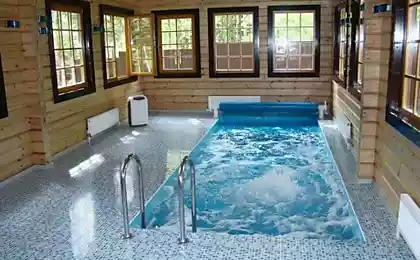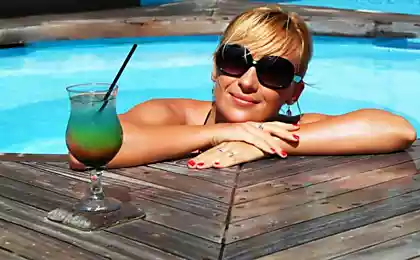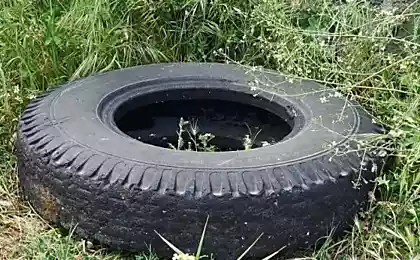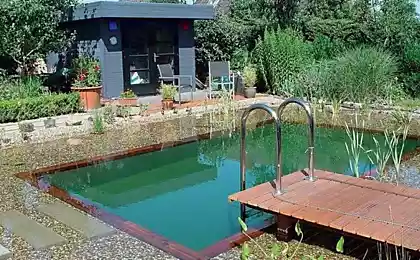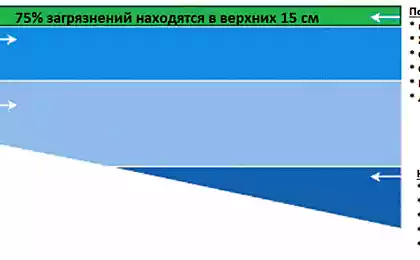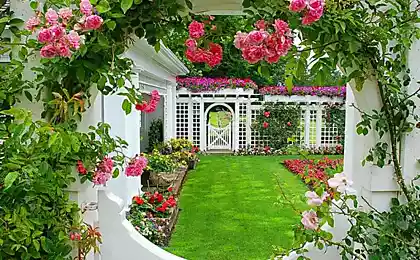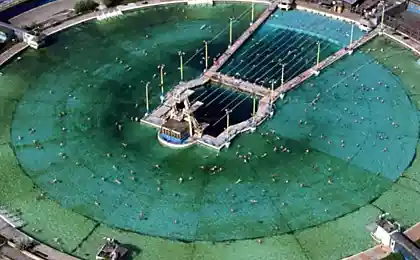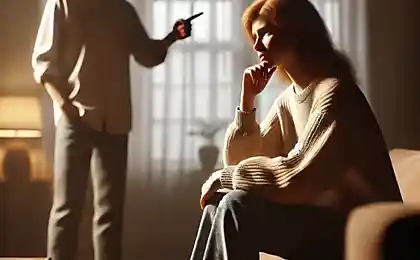486
Bathing pool in the garden: tips for creating
Water is always magically attracted the person — be it a decorative pond, pool, the murmur of the brook, the waterfall, the play of light in the jets of the fountain. Water analiziruet space, filling it with life, and improves the microclimate in the area. But how to combine the pleasure of swimming and an ornamental pond? There is a way to create a pond area.
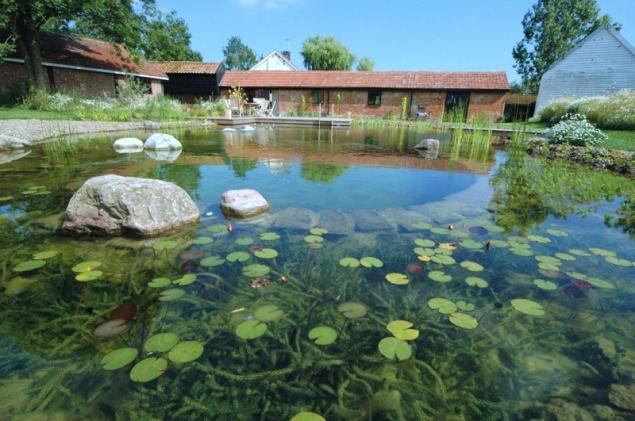
Landscaped pool area
Conventional plastic pools in areas not always fit harmoniously into the surrounding landscape, especially in the garden landscape, natural style. In addition, the pool requires a costly system of cleaning, changing water, remove it for the winter. If your intention is certainly to have a pool in your garden, then why not combine with ornamental pond? The advantages of this reservoir is obvious. It can be given any shape, there is enough space for bathing the whole family, do not need complex water treatment system — at the expense of the ecological balance it is self-purification, aquatic and semi-aquatic plants are a wonderful decoration of such a body of water, it blends in harmoniously with the landscape garden with flower beds, shrubs and trees.
Build a pond-the pool
In fact, the creation of a pond bathing can be difficult and costly, but the results are worth it. Consider its main stages. To start the construction of the pond is bath only makes sense if there is enough space on the site. Here you will have to make a choice. If you can afford to allocate to a pond of 100 sq m or at least 70 sq m, you will not need almost any equipment to clean it. Half of this area will have to allocate to regeneration zone — the area around the pool for a swim, which is occupied by plants. It maintains the purity of the water in the likeness of natural ecosystems due to the biological filter of the aquatic and riparian plants and microorganisms. This is the secret of the biological balance and purity of the water.
If space on the site is small, then the size of the bath can be reduced to 30-40 sq m and the regeneration zone will be approximately 10-20 sq. m, but then you have to use the devices pre-cleaning, filters, pumps. In this case, the pool for swimming also surrounded by a regeneration zone having a small width (1-1. 5 m), but at a certain distance in accordance with the landscape design of the plot is placed an Autonomous regeneration of the pond that has the appearance of a decorative pond with plants. This pond is 2-3 times smaller area compared to a pond-bath. It is also decorated with plants, perhaps in combination with stones, but from pool to swim in, it has water flow. Of the recovery of the reservoir through the treatment system passes the water and re-enters the pond-the pool by pumps. Thus, water purification and biological balance is maintained throughout the system.
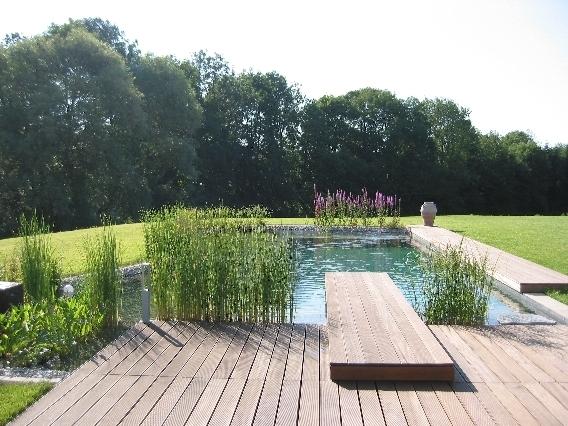
For the pond is dug a pit, the depth in the bathing area can be from 1.5 to 2m, and in the regeneration zone is from 0.5 to 1 m. the swimming Area is often rectangular, less rounded or irregular shape. It definitely has an underwater border, not reaching the surface of the water at 30-50cm, made either in the form of the narrow walls of reinforced concrete or bags of sand or fine gravel of durable material. The wall of the building before the paving of the reservoir to the bottom of the reservoir, and sand bags (3) or gravel can be laid on the coating itself. These boundaries play the role of the separation wall, preventing the ingress of water plants and silt and earth into the bathing area.
After aligning the bottom of the pit on its surface is laid a layer of damp sand layer of 10-15cm, which closes the special sacking for ponds or geotextile layer is an inert material that protects the waterproofing membrane. Then the bottom of the future reservoir shrouded to seal flexible waterproof tape — butyl rubber. This is a very durable coating, which is designed for 20 years use, if it is not damaged by sharp objects.
On the edge of bath is constructed convenient platform, usually of wooden planks on which it is good to sunbathe and relax, provides the steps to the water with railings. If you have installed sun awning or a large umbrella, and deckchairs.
We should not think that making this pond is the pool, not need about it to care more. You should regularly trim the dry parts of plants, collecting fallen leaves, clear grid filters, and every five years to carry out capital works on clearing the pond of silt and debris.
Choose plants for the pond
In the regeneration zone can be placed aquatic plants in containers, or plant them in the bulk soil. It can be the representatives of the local flora, and exotic lilies of various colors.
Thermophilic water plants (pontederia, orontium water) for the summer, too, can put into the pond, and in winter, clean cool room. Many aquatic plants growing and well-wintering with us, very decorative — it Susak umbrella, balticvent, arrowhead, marsh forget-me-not, some species of irises, Calla swamp, and others.
But it is important not only decorative, but also the efficiency of plants as green biofilters. The best in this respect are plants with tubular stems, such as bulrush or broadleaf cattail, they purify the water most rapidly, absorbing the nutrients, thereby preventing the proliferation of blue-green algae that cause algal blooms in summer. However, these plants require a lot of space and are suitable only for large ponds (at least 100 sqm). For relatively small reservoirs it is better to use smaller plants such as sedges, swamp iris, the bean trefoil. The soil in the regeneration zone necessary not only as a nutrient medium for plants and beneficial microorganisms, but also is used for natural water filtration.
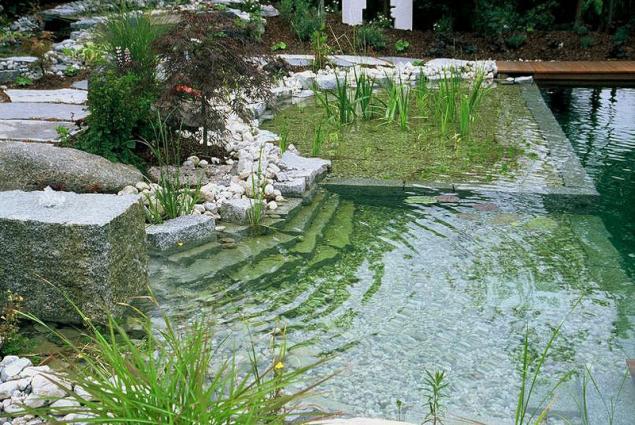
It is very important that the shore was shallow — then the pond will look more natural, and numerous small animals (hedgehogs, frogs, toads), if necessary, easily get ashore. The edge of the pond-baths are often decorated with large stones in combination with river pebbles and fine gravel.
Aquatic vegetation is gradually moving into the coastal water that surrounds the pond. This will suit the plants, taken from local waters (point and monetary loosestrife, loosestrife loosestrife, swamp milkweed, small cattail, marsh marigold, sitniki). To create more moisture conditions, at a depth of half a meter digged a film of butyl rubber or a special polyvinyl chloride, which accomplished numerous holes — it will trap moisture and create favorable conditions for plant growth.
Decorate this pond and many garden plants that tolerate excess moisture. This is the different types of host and astilbe, meadowsweet, white and purple globe flower hybrid species and varieties of botulinic, primrose, saxifrage. A little further from the pond you can plant daylilies, Siberian iris, colorful, cuff, ferns. Sometimes planted weeping willows and other shrubs at the edge of the pond. published
P. S. And remember, only by changing their consumption - together we change the world! ©
Source: garden-profi.com.ua/pools/pools1.htm

Landscaped pool area
Conventional plastic pools in areas not always fit harmoniously into the surrounding landscape, especially in the garden landscape, natural style. In addition, the pool requires a costly system of cleaning, changing water, remove it for the winter. If your intention is certainly to have a pool in your garden, then why not combine with ornamental pond? The advantages of this reservoir is obvious. It can be given any shape, there is enough space for bathing the whole family, do not need complex water treatment system — at the expense of the ecological balance it is self-purification, aquatic and semi-aquatic plants are a wonderful decoration of such a body of water, it blends in harmoniously with the landscape garden with flower beds, shrubs and trees.
Build a pond-the pool
In fact, the creation of a pond bathing can be difficult and costly, but the results are worth it. Consider its main stages. To start the construction of the pond is bath only makes sense if there is enough space on the site. Here you will have to make a choice. If you can afford to allocate to a pond of 100 sq m or at least 70 sq m, you will not need almost any equipment to clean it. Half of this area will have to allocate to regeneration zone — the area around the pool for a swim, which is occupied by plants. It maintains the purity of the water in the likeness of natural ecosystems due to the biological filter of the aquatic and riparian plants and microorganisms. This is the secret of the biological balance and purity of the water.
If space on the site is small, then the size of the bath can be reduced to 30-40 sq m and the regeneration zone will be approximately 10-20 sq. m, but then you have to use the devices pre-cleaning, filters, pumps. In this case, the pool for swimming also surrounded by a regeneration zone having a small width (1-1. 5 m), but at a certain distance in accordance with the landscape design of the plot is placed an Autonomous regeneration of the pond that has the appearance of a decorative pond with plants. This pond is 2-3 times smaller area compared to a pond-bath. It is also decorated with plants, perhaps in combination with stones, but from pool to swim in, it has water flow. Of the recovery of the reservoir through the treatment system passes the water and re-enters the pond-the pool by pumps. Thus, water purification and biological balance is maintained throughout the system.

For the pond is dug a pit, the depth in the bathing area can be from 1.5 to 2m, and in the regeneration zone is from 0.5 to 1 m. the swimming Area is often rectangular, less rounded or irregular shape. It definitely has an underwater border, not reaching the surface of the water at 30-50cm, made either in the form of the narrow walls of reinforced concrete or bags of sand or fine gravel of durable material. The wall of the building before the paving of the reservoir to the bottom of the reservoir, and sand bags (3) or gravel can be laid on the coating itself. These boundaries play the role of the separation wall, preventing the ingress of water plants and silt and earth into the bathing area.
After aligning the bottom of the pit on its surface is laid a layer of damp sand layer of 10-15cm, which closes the special sacking for ponds or geotextile layer is an inert material that protects the waterproofing membrane. Then the bottom of the future reservoir shrouded to seal flexible waterproof tape — butyl rubber. This is a very durable coating, which is designed for 20 years use, if it is not damaged by sharp objects.
On the edge of bath is constructed convenient platform, usually of wooden planks on which it is good to sunbathe and relax, provides the steps to the water with railings. If you have installed sun awning or a large umbrella, and deckchairs.
We should not think that making this pond is the pool, not need about it to care more. You should regularly trim the dry parts of plants, collecting fallen leaves, clear grid filters, and every five years to carry out capital works on clearing the pond of silt and debris.
Choose plants for the pond
In the regeneration zone can be placed aquatic plants in containers, or plant them in the bulk soil. It can be the representatives of the local flora, and exotic lilies of various colors.
Thermophilic water plants (pontederia, orontium water) for the summer, too, can put into the pond, and in winter, clean cool room. Many aquatic plants growing and well-wintering with us, very decorative — it Susak umbrella, balticvent, arrowhead, marsh forget-me-not, some species of irises, Calla swamp, and others.
But it is important not only decorative, but also the efficiency of plants as green biofilters. The best in this respect are plants with tubular stems, such as bulrush or broadleaf cattail, they purify the water most rapidly, absorbing the nutrients, thereby preventing the proliferation of blue-green algae that cause algal blooms in summer. However, these plants require a lot of space and are suitable only for large ponds (at least 100 sqm). For relatively small reservoirs it is better to use smaller plants such as sedges, swamp iris, the bean trefoil. The soil in the regeneration zone necessary not only as a nutrient medium for plants and beneficial microorganisms, but also is used for natural water filtration.

It is very important that the shore was shallow — then the pond will look more natural, and numerous small animals (hedgehogs, frogs, toads), if necessary, easily get ashore. The edge of the pond-baths are often decorated with large stones in combination with river pebbles and fine gravel.
Aquatic vegetation is gradually moving into the coastal water that surrounds the pond. This will suit the plants, taken from local waters (point and monetary loosestrife, loosestrife loosestrife, swamp milkweed, small cattail, marsh marigold, sitniki). To create more moisture conditions, at a depth of half a meter digged a film of butyl rubber or a special polyvinyl chloride, which accomplished numerous holes — it will trap moisture and create favorable conditions for plant growth.
Decorate this pond and many garden plants that tolerate excess moisture. This is the different types of host and astilbe, meadowsweet, white and purple globe flower hybrid species and varieties of botulinic, primrose, saxifrage. A little further from the pond you can plant daylilies, Siberian iris, colorful, cuff, ferns. Sometimes planted weeping willows and other shrubs at the edge of the pond. published
P. S. And remember, only by changing their consumption - together we change the world! ©
Source: garden-profi.com.ua/pools/pools1.htm

